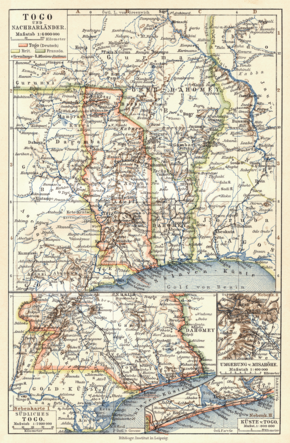Colonial toponym
A colonial toponym , also known as a colonial name , “ is a location-identifying simple or complex element of the onomasticon that refers to a geo-object in a colonial area within the time frame of the factual exercise of power . “Put simply, these are geographical names ( toponyms ) that were coined in the colonial era and / or were common in the respective colony, the corresponding mother country and mostly beyond. The interdisciplinary research field that deals with colonial place names, is the Kolonialtoponomastik . It forms an intersection especially between toponomics and colonial linguistics .
Types and structure

Colonial ponyms can be names that have been adopted by the indigenous population , if necessary with linguistic changes ( colonial endonyms and pseudo- endonyms ), names that have been newly assigned by the colonizers ( colonial exonyms ), or mixed forms ( hybrids ), which have both indigenous and colonizing name components. In addition, colonial toponyms can be common and widespread long after a country's de facto colonial period has ended (see postcolonialism ). This is mostly the case in regions where there was no pre-colonial settlement. Endonymic or hybrid colonial toponyms cannot exist in such regions.
Languages in which exonymic and hybrid colonial names were mainly coined are English , French , Spanish , Portuguese , Dutch , Danish and German . The relatively small number of predominantly Indo-European colonial languages contrasts with a much larger number of indigenous languages from the most diverse language families , which influenced the colonial names (the colonial toponomasticon ).
If they denote a settlement ( oikonyms ), are two-part, with a classifier such as -stad , -ville or Puerto , and both parts come from the language of the colonizers, such colonial toponyms are also referred to as canonical . Few of the colonial names are strictly canonical, especially in regions with pre-colonial settlement. Often (largely) canonical names honor the contemporary heads of state or other high-ranking dignitaries of the mother countries of the colony or the homeland of the person making the name. Such colonial eponyms (e.g. Philippeville , Victoria Falls and Lake Victoria in Africa) were intended to express the sovereignty of the motherland over the colony. Two-part exonymic colonial toponyms , which are a combination of the adjective neu (or new , neuw , nouveau , etc.) and a toponym from the motherland (e.g. La Nouvelle-Orléans , New Pomerania ), have a similar function ).
Change of colonial ponyms
Colonial toponyms in particular, which demonstrate a claim to sovereignty, tend to be changed when a territory is taken over by another colonial power or after it has gained sovereignty from the mother country, although they often remain in use in the mother country of the (replaced) colonial power. If, on the other hand, they persist in the colonial toponomasticon of the new colonial power, these names are referred to as alloexonyms .
However, changes in the colonial toponyms can also reflect changes in the power relations in the mother country. One example is the island of La Réunion , which was initially called Île Bourbon after it was officially taken over by the French in 1640 (after the noble family of the Bourbons , to which the French kings of the time belonged), but was renamed in Île de la Réunion in 1793 during the French Revolution , In 1803, at the time of the First Empire , it was renamed Île Bonaparte, in 1815 after the restoration of the French monarchy it was called Île Bourbon again for several decades before it was finally given its current name in the course of the February Revolution in 1848 .
The function of exonymic colonial toponyms is therefore not only the general expression of the motherland's claim to power, but sometimes also a legitimation and manifestation of the form of rule in the motherland.
literature
- Thomas Stolz, Ingo H. Warnke: Systems and discourse linguistic insights into comparative colonial toponomastics. P. 1–75 in: Thomas Stolz, Ingo H. Warnke (Ed.): Comparative Colonial Toponomastics. Structures and functions of colonial naming of places. Colonial and Postcolonial Linguistics, Volume 12. De Gruyter, 2018, ISBN 978-3-11-060503-7
Individual evidence
- ^ Daniel Schmidt-Brücken, Ingo H. Warnke, Jennifer Gräger: Complex onymic forms of the creation of places: Comments on the discourse-grammatical status of toponym constructions in colonial sources. P. 61–94 in: Nataliya Levkovych, Aina Urdze (ed.): Linguistics in the Northwest: Contributions to the 8th Northwest German Linguistic Colloquium, Bremen, November 13-14, 2015 . Diversitas Linguarum, Volume 42. Universitätsverlag Dr. N. Brockmeyer, Bochum 2017, p. 67.